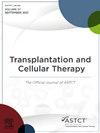Impact of Real-World Clinical Factors on an Analysis of the Cost-Effectiveness of “Immediate CAR-T” Versus “Late CAR-T” as Second-Line Treatment for DLBCL Patients
IF 3.6
3区 医学
Q2 HEMATOLOGY
引用次数: 0
Abstract
While chimeric antigen receptor (CAR-T) targeting CD19 as second-line therapy for diffuse large B cell lymphoma (DLBCL) is a promising strategy, the high costs and limited access to CAR-T pose significant challenges. When assessing the cost-effectiveness of CAR-T, we need to consider not only individual outcomes but also how to effectively integrate CAR-T into the overall treatment approach for relapsed DLBCL. We conducted a cost-effective analysis for patients with DLBCL in early relapse or primary refractory, to compare “immediate CAR-T,” which proceeds directly to CAR-T, and “late CAR-T,” which initially aims at ASCT and quickly switches to third-line CAR-T if non-responsive. The primary analysis used a patient age of 60 years, and it also examined variations from 40 to 70 years. The analysis was performed for both Japanese and US settings using a Markov model incorporating life expectancy in both countries, with extensive sensitivity analysis including factors such as age, the choice of CAR-T (lisocabtagene maraleucel or axicabtagene ciloleucel), and the opportunity to receive third-line CAR-T, to reflect real-world situations. The length of a Markov cycle was defined to be 1 month, and patients in the model were assumed to age 1 year every 12 Markov cycles. The analysis was made over a lifetime horizon, and the outcome was measured based on incremental cost-effectiveness ratio (ICER), with willingness-to-pay (WTP) thresholds of ¥7,500,000 and $150,000 per quality-adjusted life years (QALY) in Japan and the US, respectively, with an annual discount rate of 3%. Compared with “late CAR-T,” the “immediate CAR-T” strategy gained QALYs of 0.97 and 0.89 with an incremental cost of ¥5,998,354 and $88,440 in Japan and the US, respectively. The ICERs were ¥6,170,058/QALY in Japan and $99,596/QALY in the US. In the probabilistic sensitivity analysis for patients aged 60, “immediate CAR-T” was cost-effective in 54.8% and 61.7% of the 10,000 Monte Carlo iterations in Japan and the US, respectively. Sensitivity analyses showed that “immediate CAR-T” was not cost-effective when patients were over 68.4 in Japan, when the standardized mortality ratio of CAR-T and ASCT survivors was close, and when utility during treatment-free remission was low. Incorporating various clinical factors, the analysis showed that “immediate CAR-T” is more cost-effective than “late CAR-T.” However, this conclusion should be interpreted with caution, as the ICERs were very close to the WTP thresholds, and the results were highly sensitive to parameter changes.
现实世界的临床因素对“立即CAR-T”与“晚期CAR-T”作为DLBCL患者二线治疗的成本效益分析的影响:立即或晚期CAR-T作为二线治疗的DLBCL。
背景:虽然靶向CD19的嵌合抗原受体(CAR-T)作为弥漫性大B细胞淋巴瘤(DLBCL)的二线治疗是一种很有前景的策略,但CAR-T的高成本和有限的可及性构成了重大挑战。在评估CAR-T的成本-效果时,我们不仅需要考虑个体结果,还需要考虑如何有效地将CAR-T整合到复发的DLBCL的整体治疗方法中。目的/研究设计:我们对早期复发或原发性难治性DLBCL患者进行了一项成本效益分析,比较“立即CAR-T”和“晚期CAR-T”,前者直接进行CAR-T治疗,后者最初针对ASCT,如果无反应则迅速切换到三线CAR-T治疗。最初的分析使用了一个60岁的病人,它也检查了从40岁到70岁的变化。在日本和美国的情况下,使用马尔可夫模型结合两国的预期寿命进行了分析,并进行了广泛的敏感性分析,包括年龄、CAR-T的选择(lisocabtagene maraleucel或axicabtagene ciloleucel)以及接受三线CAR-T的机会等因素,以反映现实情况。一个马尔可夫周期的长度定义为一个月,模型中的患者假定每12个马尔可夫周期变老一岁。该分析是在一个生命周期内进行的,结果是基于增量成本效益比(ICER)来衡量的,日本和美国的支付意愿(WTP)阈值分别为每个质量调整生命年(QALY) 750万美元和15万美元,年贴现率为3%。结果:与“晚期CAR-T”相比,“即时CAR-T”策略在日本和美国分别获得了0.97和0.89的qaly,增量成本分别为5,998,354美元和88,440美元。ICERs在日本为6,170,058美元/QALY,在美国为99,596美元/QALY。在60岁患者的概率敏感性分析中,在日本和美国进行的10,000次蒙特卡罗迭代中,“立即CAR-T”的成本效益分别为54.8%和61.7%。敏感性分析表明,在日本,当患者超过68.4时,当CAR-T和ASCT幸存者的标准化死亡率接近时,当无治疗缓解期间的效用较低时,“立即CAR-T”并不具有成本效益。结论:综合各种临床因素,分析表明“即时CAR-T”比“晚期CAR-T”更具成本效益。然而,这一结论应谨慎解释,因为ICERs非常接近WTP阈值,并且结果对参数变化高度敏感。
本文章由计算机程序翻译,如有差异,请以英文原文为准。
求助全文
约1分钟内获得全文
求助全文
来源期刊

Transplantation and Cellular Therapy
Medicine-Hematology
CiteScore
7.00
自引率
15.60%
发文量
1061
审稿时长
51 days
 求助内容:
求助内容: 应助结果提醒方式:
应助结果提醒方式:


